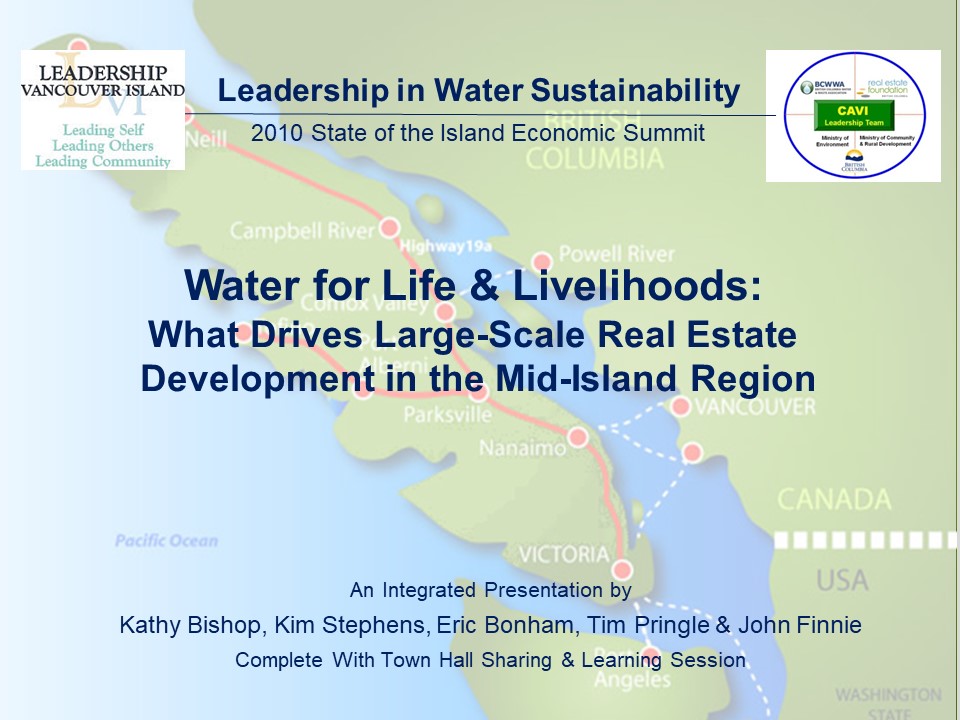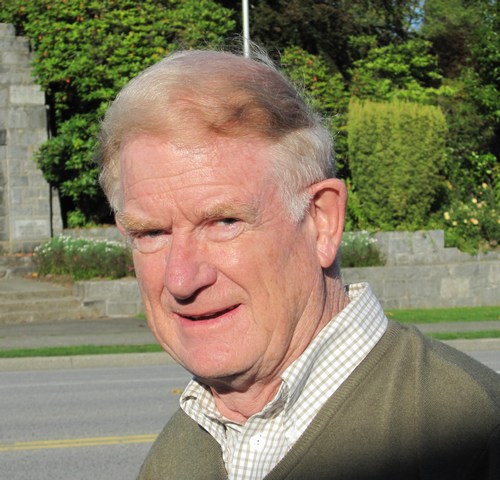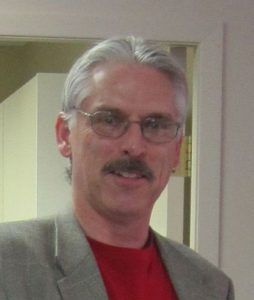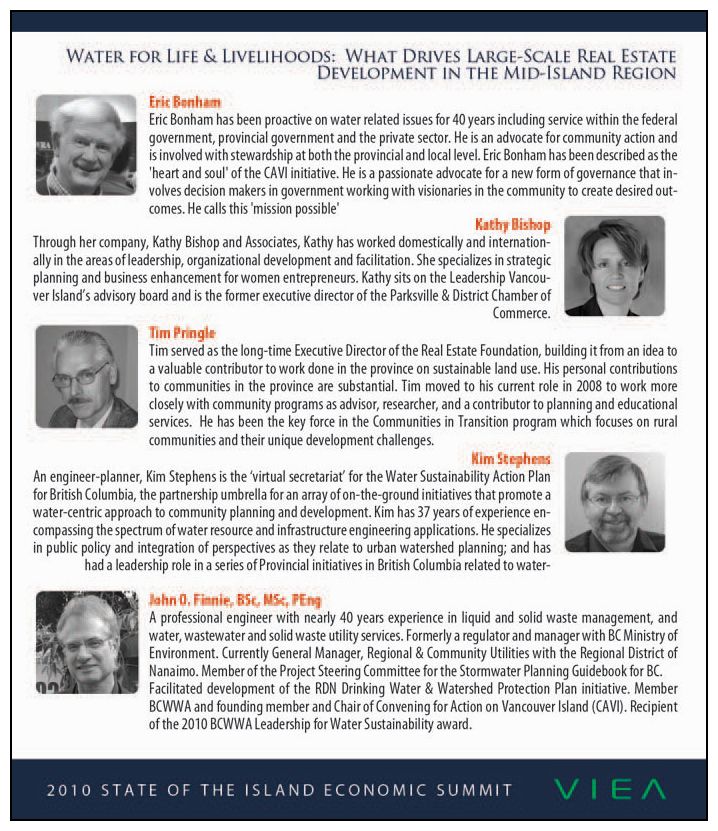STATE OF VANCOUVER ISLAND ECONOMIC SUMMIT: “Both the Convening for Action on Vancouver Island (CAVI) initiative and the Vancouver Island Economic Alliance respect regional differences while working towards a common vision founded on the principles of respect and trust,” stated Eric Bonham when he established the context for a breakout session on ‘Water for Life and Livelihoods’ (October 2010)
Note to Reader:
Released in February 2004, the Water Sustainability Action Plan for British Columbia introduced a framework for building partnerships and demonstrating what can be achieved through a ‘top-down & bottom-up strategy’ that aligns efforts at the provincial, regional and local scales to respond and adapt to a changing world.
2010 was a ‘watershed year’ for the Water Sustainability Action Plan, with outreach taking place at 10 major events in three regions, to provide peer-based learning for Living Water Smart, Building Greener Communities, and Adapting to a Changing Climate. The seventh of these events was a summit in October 2010, organized by the Vancouver Island Economic Alliance, and held at the Nanaimo Convention Centre……

2010 State of the Island Economic Summit
The Vancouver Island Summit is an annual event organized and hosted by the Vancouver Island Economic Alliance (VIEA). The 2010 Summit included a breakout session on water-centric development that was a collaborative effort of two groups: the CAVI-Convening for Action on Vancouver Island team: and the Leadership Vancouver Island society. The session was an outcome of the Dialogue in Nanaimo, held in June 2010.
VIEA supported the Dialogue in Nanaimo because VIEA viewed the event as the springboard to a session on water sustainability at the Summit.
Water for Life and Livelihoods
The objective of the Summit breakout session was to facilitate dialogue on the question “What do we want Vancouver Island to look like in 50 years?”
Major breakthroughs happen when decision-makers in government work with grass-roots visionaries in the community to create desired outcomes. When ‘convening for action’, we create a picture of the future that we want.
This interactive session on land development and water sustainability informed and educated Summit participants about a new form of governance that is taking root in the local government setting on Vancouver Island. It is quiet, silent and very effective. It starts with a vision: settlement change in balance with ecology. It is about turning the whole game around to a new way of doing business. The future desired by all will be created through alignment of federal, provincial, regional and local policies and actions:
This is what we want to collectively and incrementally achieve over time, and this is how we will work together to get there.
The phrase water for life and livelihoods conveys the fundamental principles of sustainability of natural systems in their own right and in relation to the health and wellbeing of people who benefit from the use of water for basic life needs and economic activity. Water sustainability can and will be achieved through implementation of green infrastructure policies and practices. Getting there requires a change in mind-set.
To Learn More:
Download a copy of the 2-page handout titled Water for Life and Livelihoods: What Drives Large-Scale Real Estate Development in the Mid-Island Region.
Download a copy of the Lesson Plan for the Action Plan breakout session.
Download a copy of the integrated PowerPoint presentation by Kathy Bishop, Kim Stephens, Eric Bonham, Tim Pringle and John Finnie.

Story Behind the Decision to Collaborate
“When the CAVI team reflected on closing remarks by Patrick Ross (Leadership Vancouver Island) and Cori Lynn Germiquet (VIEA), it became clear that the Dialogue in Nanaimo was indeed a stepping stone to the State of the Island Economic Summit in October 2010. We therefore concluded that it was important for CAVI be part of the Summit. This would be a key step in a process to align efforts because the Summit could serve as a springboard for action,” wrote Kim Stephens, Partnership for Water Sustainability in BC,  in an email to Kathy Bishop, Chair of the Curriculum Committee for Leadership Vancouver Island.
in an email to Kathy Bishop, Chair of the Curriculum Committee for Leadership Vancouver Island.
“This realization set the wheels in motion to scope out how the CAVI team could/would collaborate with Leadership Vancouver Island to design the water sustainability breakout session so that the Summit messaging is consistent with the Beyond the Guidebook 2010 guidance document, the release of which was announced at the Dialogue in Nanaimo.
“The CAVI team seized the opportunity to reach a new audience at the Summit, and make a bold leap forward in raising the bar for a ‘Vancouver Island vision’. Because the Leadership Vancouver Island team was also action-oriented, this resulted in a synergy for what we wished to accomplish via Beyond the Guidebook 2010. Rather than their audience reinventing the wheel, collaboration with CAVI would enable both teams to jointly build on the CAVI foundation and expand our collective reach.”
Visualizing a desired future for Vancouver Island
 “Very quickly an outline for the Summit breakout session took shape,” stated Kathy Bishop after a content development session in July 2010. “We framed two questions to be addressed. First, how does Fresh water sustainability affect economic development? Secondly, how do we generate interest/involvement about fresh water sustainability on the part of Summit participants who are focused on economic development?
“Very quickly an outline for the Summit breakout session took shape,” stated Kathy Bishop after a content development session in July 2010. “We framed two questions to be addressed. First, how does Fresh water sustainability affect economic development? Secondly, how do we generate interest/involvement about fresh water sustainability on the part of Summit participants who are focused on economic development?
“It also became clear that the session should be built around presentations by Eric Bonham and Tim Pringle of the CAVI team. Eric was passionate and articulate in rousing audiences to think about what we want Vancouver Island to look like in 50 years. Tim had done research on what drives development on Vancouver Island, and had described central Vancouver Island as being one market which provides people with choices. Tim’s work was therefore the hook for the Summit audience.”
What Do We Want Vancouver Island to Look Like in 50 Years?
 “This opportunity – that is, the State of Vancouver Island Economic Summit – sets up the next step I believe, in addressing our mantra What do we want Vancouver Island to look like in 50 years ?,” wrote Eric Bonham in August 2010. A former Director in two provincial government ministries – Environment, and Municipal Affairs – Eric Bonham was a founding member of both the Partnership for Water Sustainability and CAVI leadership teams.
“This opportunity – that is, the State of Vancouver Island Economic Summit – sets up the next step I believe, in addressing our mantra What do we want Vancouver Island to look like in 50 years ?,” wrote Eric Bonham in August 2010. A former Director in two provincial government ministries – Environment, and Municipal Affairs – Eric Bonham was a founding member of both the Partnership for Water Sustainability and CAVI leadership teams.
“When I met Kathy Bishop in Nanaimo in the early summer I mentioned to her, on a one to one basis, that I thought she had an important role to play in bringing together the various interests to focus on the common vision ‘What do we want Vancouver Island to Look like in 50 years?’ I suggest the Summit has the potential to set the stage for such a discussion.
“It also brings credibility to the efforts of CAVI to date, although our focus is water related. If we do not get this part of the puzzle right the rest, in my opinion, loses significance.”
Get Ahead of the Curve
“I think it is unreasonable to expect that the population of Vancouver Island will not increase. Following the Winter Olympics there has been considerable interest in investing in Vancouver Island. Tim Pringle has indicated where the growth patterns might be in his ‘one market’ research.
“My sense is that we have ‘to get ahead of the curve’. Unless there is a creative 50-year vision ‘with some teeth’ put out there, Vancouver Island will inevitably experience ‘death by a thousand cuts’. In short, and guided by this vision, any future development on Vancouver Island would be subject to balancing the economy with the ecology which entails a water-centric approach.
“This leads to the discussion of the bigger question, how do we value natural systems? The economic value of Vancouver Island is highly dependent upon its ecology and natural beauty. Thus, it strikes me that the Summit has an opportunity to make a significant contribution by addressing two core questions:
- What do we want Vancouver Island to look like in 50 years. 50 years is but a fleeting second in time, however setting a new way of doing business will echo down through the ages.
- How do we do business differently that ensures balance of the economy and the ecology, as Tim Pringle has demonstrated with his see-saw balance slide.
“Finally, why not come out of the summit with a Vancouver Island Sustainability Accord that sets a ‘road map’ for the island’s future? Furthermore, perhaps coming out of this could be the setting up of an Elders Group’.”
Vision for an Elders Group
“There was a very interesting article in the Times Colonist newspaper (in July 2007, written by a Vancouver Island woman. The article built upon such global leaders as Nelson Mandela and Jimmy Carter, two visionaries offering a different future, with the idea that we follow their lead and think ‘big and long-term’ for Vancouver Island.
“An elders group established from the interests represented at the Summit could be a powerful force for change – provided that personal interests can be set aside for the greater good. I believe that the First Nations could play a significant role in bringing this vision together, given their native wisdom.
“I raise these ideas with the thought that our presentation at the Summit by addressing this vision, as seen through the lens of water-centric sustainability, could well strike a chord with delegates. Furthermore, I believe we are being true to our own path by promoting these ideas, better still if the conference organizers take this idea as the Summit theme, I believe it could carry weight particularly so given that Premier Campbell will be present,” concluded Eric Bonham.
In his keynote address at the Summit, Premier Gordon Campbell did in fact call for the form of collaboration demonstrated by the VIEA-CAVI relationship.
One Market, from Cobble Hill to Campbell River
In 2009, research undertaken by Tim Pringle, concludes that the real estate development in the mid-Island region is a common market. This one market concept suggested that communities, can choose from among development proposals, and can therefore control their destinies.
 “The mid-Island communities have the assets that developers need to be successful. Community values that are focused on the ultimate goal of settlement in balance with ecology ought to direct decisions on development proposals. And if communities align their efforts to achieve a shared vision, this will go a long way to determining what Vancouver Island as a whole will look like in 50 years,” stated Tim Pringle in 2009. For 20 years, he was the Executive Director of the Real Estate Foundation of BC. At the time, he was REFBC Director of Special Programs, prior to retirement in 2010.
“The mid-Island communities have the assets that developers need to be successful. Community values that are focused on the ultimate goal of settlement in balance with ecology ought to direct decisions on development proposals. And if communities align their efforts to achieve a shared vision, this will go a long way to determining what Vancouver Island as a whole will look like in 50 years,” stated Tim Pringle in 2009. For 20 years, he was the Executive Director of the Real Estate Foundation of BC. At the time, he was REFBC Director of Special Programs, prior to retirement in 2010.
“The concept that there is one market, from Cobble Hill to Campbell River, is our synthesis of what we have been exposed to over the past three years, the many conversations that we have had and heard, and what our research tells us. This process has yielded a fuller and strategic understanding of current, persistent context of settlement change.”
Introduction to the Distributed Benefits Argument
In August 2010,m Tim Pringle wrote that “my current focus regarding the ‘one market concept’ is to detail and support the ‘distributed benefits’ argument about ‘Master Planned developments (communities). Master planned is a neutral term. It does not mean either ‘desirable’ or ‘not desirable’. The challenges concerning the argument are two-fold.
“First, that large projects will be built out over time. External factors will influence or, possibly, disrupt completion of the intended build-out. External factors include the degree of dependence on external markets – for example:
- Can the potential migrant sell property in their current market in order to relocate to the mid-island region of Vancouver Island?
- If the potential buyer is a foreign investor or potential immigrant, will economic and immigration realities support or hinder their plans?
- What if air travel costs rises substantially?
“Internal or local factors also will affect these projects for example:
- What if the regional economy sags for a number of years?
- What if the regional economy overheats and trades persons are not available or costs go up too much?
- What if ecological problems arise due to climate change that induce water shortages?
“Secondly, the distributed benefits arguments is premised on the theory that WHAT the development may be is more important than WHERE it is located – for example, what happens when a locale gets too much of one kind of development? This is the case in the Columbia Valley where there is extensive recreation property development to serve the Calgary market,” concluded Tim Pringle.

YouTube Videos
Watch Kim Stephens and Kathy provide contextual remarks on collaboration and convening for action (9 minutes)
“On Vancouver Island, we know that to be a flagship model for freshwater sustainability, we need to keep asking the right questions and get into action on those right questions – for example, what is that we want Vancouver Island to look like in 50 years,” stated Kathy Bishop. She sits on the Board of Leadership Vancouver Island, a community-based leadership program that develops skills in upcoming leaders.
“In June, the Board hosted the first annual leadership dialogue at Vancouver Island University. We decided on freshwater sustainability as the theme because water is essential for all of us. As the project lead for the Dialogue in Nanaimo, the first thing I did was Google ‘water sustainability + Vancouver Island’. Up popped CAVI. And up popped the name of Kim Stephens as the contact. Within 20 minutes of sending Kim an email, he replied. Talk about a rapid response!”
Watch Eric Bonham describe the nature of CAVI-VIEA collaboration (2:17 minutes)
“The CAVI initiative and the VIEA entity both have a regional focus within a broader framework of Vancouver Island. Both respect regional differences while working towards a common vision founded on the principles of respect and trust. Both recognize that partnerships and collaboration are fundamental to success, consisting of a coalition of equals working across jurisdictional boundaries – a coalition that consists of the public and private sectors, and the community,” stated Eric Bonham.
“Both understand the need to look at Vancouver as a whole. Both recognize the benefit of bringing visionaries and like-minded people together. The common denominator is water – for an efficient economy and efficient use of water are inextricably linked. In essence, it is all about partnerships and collaboration, and embracing a shared vision. Simply put, a desire to work together as a team for Vancouver Island from the environmental, economic and social perspectives.”
Watch Tim Pringle describe what drives large-scale real estate development in the Mid-Island region (2:20 minutes)
“What are large-scale projects? The provincial government has a major projects inventory that they maintain. Those are projects proposed for development. It doesn’t mean that all of them will get built. In fact, most won’t, for a number of reasons. But some of them will be built; and the larger ones offer a range of advantages and perhaps disadvantages,” stated Tim Pringle.

